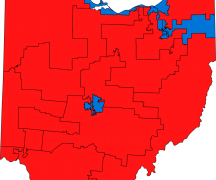By JAN LARSON McLAUGHLIN
BG Independent News
Joan Callecod doesn’t want the next map of Ohio congressional districts to be drawn up like the current lines – in a hotel room, away from the public view.
Ohio’s current congressional district lines were devised in a hotel room, called “the bunker,” Callecod said Tuesday evening during a presentation on Issue 1 appearing on the May 8 ballot. Callecod, a member of the League of Women Voters in Bowling Green, explained the need for Issue 1 to pass in order to get rid of gerrymandering in Ohio’s congressional districts.
Gerrymandering is the manipulation of congressional district lines to benefit one political party or the other. In the current case, since the Republicans were in control when the lines were drawn after the last U.S. Census, the GOP benefits.
“In partisan gerrymandering, the legislators choose their voters. The voters don’t choose their legislators,” Callecod said.
Issue 1 would require the process of drawing lines to be transparent, and require bipartisan support of the changes. The process would also limit the cases where cities, villages or townships are divided into separate congressional districts.
Ohio state districts already went through redistricting reform in 2015. The issue on the May ballot covers the U.S. congressional districts for Ohio.
Regardless of which party benefits from gerrymandering, the system is wrong, Callecod said.
Under the present congressional lines, only 3 percent of the 435 congressional districts have truly contested elections, she said.
“To me, that’s disgraceful,” Callecod said.
Ohio’s current process allows the majority party to dissect counties and cities to create districts that favor the party in power. Under the existing map, drawn by Republicans in 2011, the GOP holds 12 of Ohio’s 16 seats while only winning 56 percent of the votes.
Callecod is hopeful that ballot issue will be approved by Ohio voters.
“We are not aware of any opposition,” she said.
Here’s how the new plan would work:
- The General Assembly has an opportunity to draw a map, passage of which requires a three-fifths majority of each chamber, including support of at least half the minority party.
- Should the state legislature fail to meet these vote requirements, then the Ohio Redistricting Commission has the opportunity to pass a 10-year congressional redistricting plan requiring approval of at least four of seven votes, including affirmation votes from two members representing each of the two major parties.
- If the commission cannot reach the necessary consensus, the legislature can pass a map with one-third minority support, or pass a map with a simple majority and no minority party support that will only last four years and be subject to strict rules forbidding gerrymandering and limiting division of counties.
If passed, the amendment will become part of the Ohio Constitution and will be implemented after the 2020 census.
The ultimate goal was to get congressional district lines drawn so that the elections aren’t decided before the votes are cast.
Groups like the Bowling Green League of Women Voters have a Plan B in case voters don’t approve Issue 1 in May. Signatures are being collected across the state just in case the groups need to get the issue placed on the November ballot.
According to Callecod, the groups have collected between 250,000 and 300,000 signatures so far, but need just over 300,000 certified signatures to get on the ballot.





